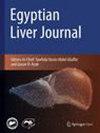To compare the HOMA-IR and metabolic profile in lean and obese subjects with non-alcoholic fatty liver disease
IF 0.7
Q4 GASTROENTEROLOGY & HEPATOLOGY
引用次数: 0
Abstract
Non-alcoholic fatty liver disease (NAFLD) is primarily perceived as a condition prevalent among obese individuals. Its pathogenesis is closely intertwined with metabolic syndrome components. However, the association between insulin resistance and NAFLD in nonobese individuals remains ambiguous. Observational studies have scrutinized the prevalence of insulin resistance and metabolic syndrome in lean NAFLD patients. This is an observational study, and NAFLD screening was carried out among inpatient and outpatient attendees at SRM Medical College’s General Medicine Department. Out of 200 screened patients meeting inclusion and exclusion criteria, 80 were diagnosed with non-alcoholic fatty liver disease (NAFLD). The assessment of metabolic syndrome was performed using the NCEP-ATP III criteria, allowing for comparison between groups concerning insulin resistance and metabolic parameters. Among NAFLD patients, those in the obese age group exhibited a higher prevalence of hypertension (57.8%; p < 0.001) and metabolic syndrome (75.6%; p < 0.0001). The lean NAFLD group showed elevated HOMA-IR levels (4.16) compared to obese NAFLD patients (2.92), with a significant statistical disparity (p < 0.0001). Additionally, the HSI value significantly increased in obese NAFLD patients (p < 0.00001). Insulin resistance, a key factor in metabolic syndrome, is prevalent in lean individuals with non-alcoholic fatty liver disease (NAFLD), playing a pivotal role in its development. This resistance, linked to metabolic syndrome, promotes hepatic triglyceride and fatty acid accumulation, leading to NAFLD. Moreover, insulin resistance correlates significantly with weight gain in NAFLD patients.比较患有非酒精性脂肪肝的瘦人和肥胖者的 HOMA-IR 和代谢特征
非酒精性脂肪肝(NAFLD)主要被认为是肥胖者的一种常见病。非酒精性脂肪肝的发病机制与代谢综合征密切相关。然而,在非肥胖人群中,胰岛素抵抗与非酒精性脂肪肝之间的关系仍不明确。观察性研究仔细研究了非酒精性脂肪肝患者中胰岛素抵抗和代谢综合征的患病率。这是一项观察性研究,对SRM医学院全科医学系的住院和门诊病人进行了非酒精性脂肪肝筛查。在符合纳入和排除标准的 200 名筛查患者中,80 人被确诊为非酒精性脂肪肝(NAFLD)。代谢综合征的评估采用 NCEP-ATP III 标准,以便对各组之间的胰岛素抵抗和代谢参数进行比较。在非酒精性脂肪肝患者中,肥胖年龄组的高血压(57.8%;p < 0.001)和代谢综合征(75.6%;p < 0.0001)发病率较高。与肥胖非酒精性脂肪肝患者(2.92)相比,瘦弱非酒精性脂肪肝患者组的 HOMA-IR 水平更高(4.16),两者之间存在显著的统计学差异(p < 0.0001)。此外,肥胖非酒精性脂肪肝患者的 HSI 值也明显升高(p < 0.00001)。胰岛素抵抗是代谢综合征的一个关键因素,在患有非酒精性脂肪肝的瘦弱患者中普遍存在,在其发展过程中起着举足轻重的作用。胰岛素抵抗与代谢综合征有关,会促进肝脏甘油三酯和脂肪酸的积累,从而导致非酒精性脂肪肝。此外,胰岛素抵抗与非酒精性脂肪肝患者的体重增加密切相关。
本文章由计算机程序翻译,如有差异,请以英文原文为准。
求助全文
约1分钟内获得全文
求助全文

 求助内容:
求助内容: 应助结果提醒方式:
应助结果提醒方式:


